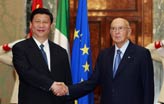Photos
Medical tourism getting popular among the rich
Updated: 2011-06-04 09:45
By Shan Juan (China Daily)
Big and getting bigger
Medical tourism is worth about $60 billion worldwide ,according to report by Deloitte. Further increases are expected as people age and seek more affordable treatments around the world.
Stephano, whose association promotes medical tourism, said that popular destinations include Argentina, Brunei, Cuba, Colombia, Costa Rica, Hong Kong, Hungary, India, Singapore, Thailand and, more recently, Saudi Arabia, the United Arab Emirates, South Korea, Tunisia and New Zealand.
To cash in on the trend, more than 50 countries have identified medical tourism as a national industry.
Medical tourism on China's mainland is primarily outbound, Stephano said. "What we need to do is try to develop patients inbound by letting people everywhere know that there is high-quality, affordable accessibility for medical services here," she said.
Traditional Chinese medicine and a combination of Eastern and Western medicine are unique to China, she said, and would provide a competitive edge.
Ciming's Hu suggested that Chinese authorities invest a bit more to address staff training and language and cultural barriers. He also urged the central government to develop a strategy and guidelines to build the industry.
He said encouraging measures might include a simplified visa application for medical tourism, programs catering to foreigners at large public hospitals, risk controls, and strengthened communication and cooperation with insurance companies worldwide.
Only limited regions - Hainan and Guangdong provinces, Shanghai and Beijing - have policies and platforms to develop inbound medical tourism featuring low-priced experimental medical procedures such as stem-cell treatment and TCM therapies, said Yang Jian, CEO of the Shanghai Medical Tourism Platform.
"The industry, if well developed, would benefit domestic health providers and stimulate more spending of coming visitors."
For example, Yang said, three TCM clinics on tropical Hainan island recorded annual income of 100 million yuan from Russian patients alone.
Also, "given our practical reality, China can provide medical treatment for certain diseases that are rarely seen elsewhere." Yang said his organization has been talking with US miners suffering from black lung disease about treatment in Shanghai.
He estimated that 10,000 to 20,000 foreigners came to Shanghai for medical services each year from 2008 to 2010.
Many are from the US, where roughly 50 million people have no health insurance and come to China for procedures such as cancer treatment using Gamma Knife and stem cell at more affordable prices, Yang said. "Usually it's a two- to four-week stay, which costs an average of $10,000."
 |
|
Visitors watch as traditional Chinese medicine is made at Ditan Park in Beijing. [Photo by Zhao Bing / For China Daily] |
There are risks
Not all countries that are going after medical tourists may be safe, Stephano said, because accreditation and other measures of quality vary widely.
"Our association provides education and messages about global choices for medical services for the people to enable them to decide on their own," she said.
Some risks are common to tourism in general, experts warned, but others involve such issues as limited access to quality post-operative care and varied standards for healthcare around the world.
Qiu Renzong, a bioethics researcher at the Chinese Academy of Social Sciences, raised the possibility of major ethical issues such as the illegal trade of organs and tissues for transplant.
China banned transplant tourism and trade of organs for transplant in 2007.
Qiu also said that while stem cell treatment attracts many medical tourists, "in fact it is recognized by Chinese health authorities as on clinical trial, thus should not be widely practiced clinically".
Qiu urged the government to strengthen regulation over medical tourism even if it's still at its early stage.
E-paper

Harbin-ger of change
Old industrial center looks to innovation to move up the value chain
Chemical attraction
The reel Mao
Improving app-iness
Specials

Vice-President visits Italy
The visit is expected to lend new impetus to Sino-Italian relations.

Birthday a new 'starting point'
China's national English language newspaper aims for a top-notch international all-media group.

Sky is the limit
Chinese tycoon conjures up green dreams in Europe with solar panels

